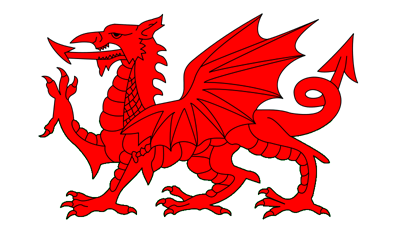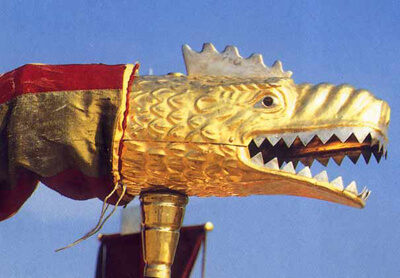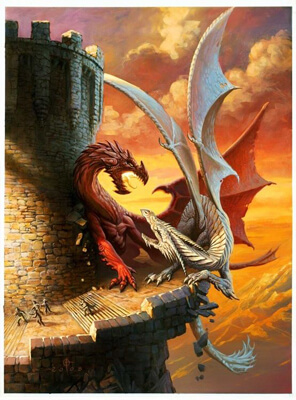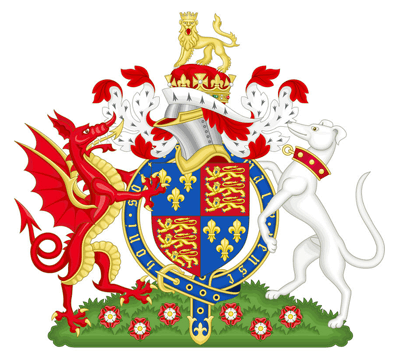Why is there a Dragon on the Welsh Flag?
The Red Dragon (Y Ddraig Goch) stands proudly with one foot raised on a green and white background. But why is there a dragon on the Welsh Flag? What does a mythical creature, like a dragon, have to do with Wales?
The red dragon has been associated with Wales for centuries and the Welsh flag is claimed to be one of the oldest national flags still in use. However, the appearance of the dragon has been adapted and changed over the years and there are several different versions in existence. The current version of the dragon on the Welsh flag was officially adopted in 1959. It is based on an old royal badge used by British kings and queens since Tudor times. But the real answer to why there is a dragon on the Welsh flag lies in Welsh mythology and history.

red dragon
The 'Draco' Symbol:
One theory is that in the early fifth century, the Welsh kings of Aberffraw used the dragon to symbolise their power and strength after the Romans withdrew from Britain. The 'draco' (dragon) head, which was brought to Britain by the Romans, was used as an emblem as their standard in battle. The emblem remained strong within Welsh culture after the invasion due to the Romano-Britons that remained.

The Myth of Merlin:
However, there is another tale linking back to the fifth century that suggests another reason as to why there is a dragon on the Welsh flag. Vortigern, a fifth century war lord and king of the Britons at the time of the Saxon arrival, wanted to build a fort near Beddgelert. He came across many problems though and sought the help of Merlin, a powerful wizard. Merlin told him to dig down and create better foundations. On doing so, he found a red and a white dragon.
The two dragons rose up and began to fight, with the red dragon being victorius. Merlin explained to Vortigern that the white dragon represented the Saxons and the red dragon represented the Welsh. He told Vortigern that this was proof that one day the Welsh would push the Saxons out of Britain and from this point on, the red dragon became a symbol for Wales.

The Red Dragon of Cadwaladr:
The story of the warring red and white dragons, linked to the myth of Merlin, was also used during the 'War of the Roses' by various contenders as part of their claim to the throne.
As part of this story, Merlin predicted that the Saxons would be beat by the Celts if Cadwaladr (a future King of Gwynedd - AD 655 to 682) sacrifices his personal power for the sake of his people. By renouncing the throne, Merlin said it would eventually lead to the restoration of British control of the island in the future. Cadwaladr, according to Geoffrey of Monmouth, heard this prophesy and did exactly that - renouncing the throne so that Merlin's prediction could come true in the future.
The Tudors:
And although Owain Glyndwr raised the dragon standard in 1400 as a symbol of revolt against the English Crown, the dragon was brought to England by Edward IV who used the tale of the dragon of Cadwaladr to claim the throne. He asserted that he would be restoring the authentic ancient lineage of Cadwaladr, thus fulfilling Merlin's prophecy of the victory of the red dragon.
When this didn't happen, the Tudors then claimed their descent from Cadwaladr to legitimise their authority over Britain, starting with Owen Tudor who carried a red dragon badge. Then when Henry Tudor landed in Wales in 1485, he adopted the red dragon flag and claimed to be returning in fulfilment of the prophesies of Merlin as recorded by Geoffrey of Monmouth. After Henry VII's victory at the Battle of Bosworth, he was greeted at the gates of Worcester with a poem asserting:
Cadwallader's blood lineally descending,
Long hath be told of such a prince coming.
Wherefore friends, if that I shall not lie,
This same is the fulfiller of the prophesy.
(Dobin, Howard, Merlin's Disciples: Prophecy, Poetry, and Power in Renaissance England, Stanford University Press, 1990, p.51.)
The Welsh dragon was thereafter referred to as the "Red Dragon of Cadwallader" and used as Henry's personal emblem. The House of Tudor continued to use this emblem as a nod to their Welsh dynasty and during Henry VIII's reign the red dragon on a green and white background became a favourite emblem on Royal Navy ships.

The current Welsh Flag:
So the reason we have a red dragon on the Welsh flag links back to fifth century history and mythology and remains to this day a symbol of pride and strength. It still sits on top of the Tudor colours of green and white and today the flag can be seen flying from the Senedd in Cardiff and from the Wales Office in Whitehall, London each day.
The dragon on the Welsh flag is contunuously used by those in the arts, sport and business to show a sense of patriotism or recognition of Wales. For example, during the 1999 Rugby World Cup, which was hosted in Wales, the opening ceremony used the motif of the dragon several times. This patriotism has continued in both rugby and football international games with fans carrying huge Welsh Dragon flags to fly during the match.
In music, the flag is commonly flown by Welsh stars and was memorably worn on a dress by the Welsh singer Shirley Bassey. The singer Cerys Matthews also often adorned her clothes with pictures of the Welsh dragon. Other musicians to have used the flag, include Nicky Wire of Manic Street Preachers, who will often drape the Welsh flag over amps when playing live and classical singer Katherine Jenkins, who has taken the flag on stage during live performances all over the world.
The popularity of the dragon and the Welsh flag seems to be increasing with Welsh nationals refusing to let their relatively small country size and fairly unknown native tongue go unnoticed... and rightly so.
A range of beautiful Welsh Dragon gifts can be found here:
https://www.housenameplate.co.uk/modern-acrylic-round-house-sign-with-welsh-dragon-emblem.html
https://www.housenameplate.co.uk/personalised-black-dublin-postbox-with-welsh-dragon-design.html





